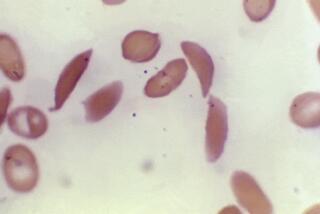Drug may ease pain of sickle cell anemia
- Share via
Sickle cell anemia causes a cascade of painful and disabling complications that lead to frequent hospital stays and a shortened life expectancy. Yet there are few treatment options for the genetic blood disorder, which afflicts millions of people worldwide, including about 80,000 Americans who are mostly of African descent. However, a novel therapy may ease symptoms and diminish the chronic damage to vital organs that leads to early death.
The drug, called ICA-17043, is a chemical cousin to clotrimazole, an antifungal medication long used to treat vaginal yeast infections and athlete’s foot. Early tests indicate the treatment reduces the sickling of red blood cells, a process in which the round blood cells stiffen and become crescent shaped so they can’t pass easily through blood vessels.
“If current studies show it’s effective, this drug could be a significant advance,” says Dr. Cage S. Johnson, director of the Comprehensive Sickle Cell Center at USC’s Keck School of Medicine.
Sickle cell anemia is caused by defective genes that produce an abnormal form of hemoglobin, the compound in red blood cells that carries oxygen. Once they release oxygen, the errant hemoglobin molecules form long rigid rods. This bends the red blood cells into a sickle shape and also causes them to lose water. The dehydrated cells harden, and this rigidity greatly accelerates the tendency to sickle. “It’s a vicious cycle,” says Dr. Carlo Brugnara, a Harvard pathologist who helped develop ICA-17043 and who is the director of the hematology laboratory at Children’s Hospital Boston.
The stiff, misshapen blood cells are unable to squeeze through blood vessels, causing a blockage that deprives cells and tissues of vital nutrients and oxygen (which is akin to having mini heart attacks). This blockage triggers painful crises that damage bones and lungs, kidneys, liver and other organs, depending on where the blockage occurs. It can also cause leg ulcers, blindness, mental retardation and strokes if the brain is affected. Because the sickle cells are abnormal, the body kills them at a faster rate than it can replace them, which causes anemia and makes sufferers extremely fatigued and more susceptible to infection.
The novel once-a-day pill works by plugging up a channel in the red blood cell’s membrane, which is ruptured when the red blood cells sickle. “It’s like opening up a drain -- all the water flows out,” explains Brugnara. “But blocking this channel keeps the cell hydrated, which results in much less sickling.”
A recent clinical trial of ICA-17043 involved 90 sickle cell patients, half of whom received the drug while the remainder got a placebo, or ineffective pill. Although the final results won’t be released until December, the preliminary data was encouraging to researchers. “The drug improved anemia, and reduced the number of dehydrated cells and the premature destruction of red blood cells,” says Brugnara.
A larger test is scheduled to start in 2005, though it may be several years before the drug is available to patients. “We’re not talking about a cure,” says Johnson. “But this drug could lessen the frequency and severity of attacks, and prevent organ damage, which would make it a crucial addition to our therapeutic arsenal.”
*
(BEGIN TEXT OF INFOBOX)
Treatments to relieve symptoms
During the last 15 years, scientists have developed treatments that can ease symptoms and stave off complications from sickle cell anemia, says Dr. Cage S. Johnson of USC’s Keck School of Medicine.
The only drug approved to treat severe sickle cell anemia in adults is hydroxyurea, a leukemia drug that reduces the frequency of painful crises (acute attacks) by stimulating production of normal hemoglobin. In addition, when patients have crises, painkilling drugs and intravenous fluids can relieve symptoms and prevent serious complications.
Blood transfusions also are used to correct anemia by increasing the number of normal red blood cells; they can also help prevent recurring strokes in children at high risk. Prescribing oral antibiotics to young children with the sickle cell gene, starting at about 3 months of age until age 5, can lessen the likelihood of pneumonia, which often was fatal to these children.
-- Linda Marsa






